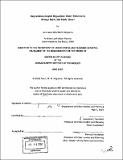Degradation despite regulation : water pollution in Billings Basin, Sao Paulo, Brazil
Author(s)
Nogueira, Ana Laura Wey Martz, 1974-
DownloadFull printable version (12.52Mb)
Other Contributors
Massachusetts Institute of Technology. Dept. of Urban Studies and Planning.
Advisor
Lawrence E. Susskind.
Terms of use
Metadata
Show full item recordAbstract
Billings Basin, a water reservoir in the Sao Paulo Metropolitan Region of Brazil, suffers from pollution. When the Billings Dam was built, industrial and energy sector interests prevailed, encouraged by Brazil's authoritarian government. The dam was part of a system that pumped water from the two most important rivers in the Sao Paulo Metropolitan Region for energy generation at the Henry Borden Hydroelectric power plant. While the reservoir was originally constructed as part of a large hydroelectric project, it has since become a crucial source of drinking water for the region. However, the engineer who planned the system warned that if no corrective measures were taken, the scheme would pollute the water in the reservoir. This is indeed what happened. In the mid-1970s, two state environmental laws were enacted to protect watershed areas in Sao Paulo. Rapid development, including the growth of uncontrolled settlements (favelas) also occurred around Billings Basin. The reservoir became polluted. However, the extent of pollution, while serious, did not seem proportional to the amount of demographic and developmental pressures on the environment of the reservoir. This paper asked whether the state environmental laws, aimed at protecting watershed areas of the Sao Paulo Municipal Region, had a substantial role in preventing total environmental degradation in Billings Basin and if not, which external pressures contributed to maintaining the pollution below a critical point. The study suggests that the laws, in fact, did not seem to have been responsible for the lower than expected levels of pollution because they were ineffective and had intrinsic weaknesses. The pollution in Billings Basin should have reached critical levels because of demographic and developmental pressures. However, the history of the basin showed that when the pollution was about to reach critical levels, external pressures - and not the laws - prompted efforts to guarantee a less than catastrophic level of environmental degredation. These external pressures seem to have been linked to such factors as the positive response to environmental issues by new political groups ascendant in state and metropolitan politics in Sao Paulo, pragmatic action in resource management by state water agencies, and the community-based actions of organized low-income groups living around the reservoir. These external forces may indicate the emergence of a democratization process in Brazil, and may herald a more decentralized and participative model for environmental management in the Sao Paulo Metropolitan Region.
Description
Thesis (M.C.P.)--Massachusetts Institute of Technology, Dept. of Urban Studies and Planning, 2002. Includes bibliographical references.
Date issued
2002Department
Massachusetts Institute of Technology. Department of Urban Studies and PlanningPublisher
Massachusetts Institute of Technology
Keywords
Urban Studies and Planning.